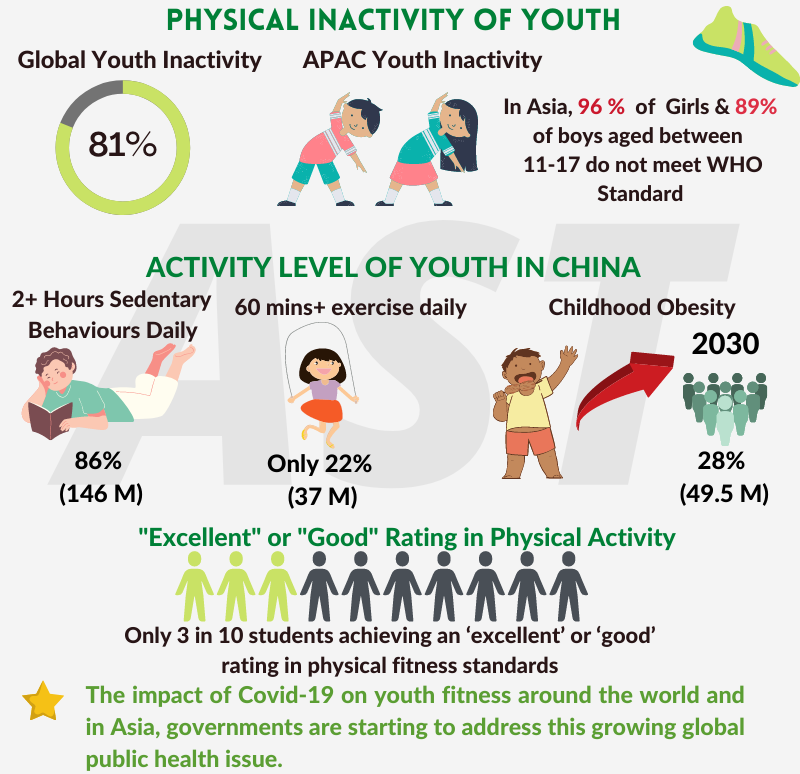
Youth were physically inactive long before Covid
According to a WHO study, 81% of global adolescents aged 11-17 years were insufficiently physically active and the region with the highest prevalence of insufficient activity was high-income Asia Pacific. Girls were even more inactive than boys with 95.6% vs 89% respectively not meeting WHO recommendation of at least 60 minutes of moderate to vigorous intensity physical activity per day.
In China, the level of physical activity amongst youth aged between 6-17 is generally low. The physical activity and health in a 2020 study of Chinese children and adolescents indicated that 86% (146 million) of this youth group engage in sedentary behaviors longer than 2 hours per day, while only 22% (37 million) of school students engage in any type of daily physical activity that lasts 60 minutes or more. As well, only 3 in 10 students achieved an ‘excellent’ or ‘good’ rating in physical fitness standards. Lack of physical activity also leads to the rise of diseases like childhood obesity in China. Between 1995 and 2014, only 1 in 5 children and adolescents being either overweight or obese. It is projected that the prevalence of childhood obesity will affect over 28% (49.5 million) Chinese children by 2030. With the recent impact of Covid-19 on youth fitness around the world and in Asia, governments are starting to address this growing global public health issue. China’s recently announced Five-Year National Fitness Plan is a great example that will significantly transform China’s fitness ecosystems and related industries.

Benefits of using digital coaching platforms
New digital coaching technologies have been used to increase student engagement thanks to their unconventional way of teaching students. By using digital coaching, students will be more self-aware of their performance and what they need to improve to refine their skills as they can record themselves and document their progress. Data management systems are making it easier to spot patterns as these platforms provide comprehensive real-time analysis. This enhances the efficiency of coaches to assess the physical stamina and movements of students while being able to provide immediate feedback. Implementing these technologies into coaching creates a win-win solution for both coaches and students while providing better results.
Apps that offer guided training allow students to access information, create goals, build routines, analyze performance, and make progress regarding their training with just a few clicks. This makes professional training highly accessible. They can also be connected with devices or wearables to track their performance. For example, the RunMotion Coach app provides runners with virtual coaches and training plans to help young athletes achieve their goals. Uplift Labs, a startup that provides remote coaching and a camera-based biomechanical analysis solutions allows remote virtual coaching and helps athletes and coaches communicate remotely in real-time and thus allowing athletes to train more consistently, reduce injuries and stay “game-ready” all the time. Another company, Kinduct enables accurate data collection from multiple devices, analyses the data and provides insights and reports on an athlete’s key metrics. This makes it easier for coaches to provide feedback and recommendations for young athletes while also being able to share their progress with their peers or their parents. In addition to digital coaching apps, the virtual fitness solution market in APAC is also anticipated to surge, to US$15 billion by 2027 at a growth rate of 34.9%, as pro-fitness government policies in Asian countries such as China, South Korea and India fuel the adoption of virtual fitness solutions in the region.
Opportunities in Asia
A report from the American Academy of Pediatrics stated, “What makes sports really engaging for youth is trying hard, making progress, being a good sport and experiencing positive coaching.” A problem in Asia is that not many schools offer comprehensive sports programs like they do in North America or Europe, leading parents to turn to external coaching programs or academies that offer children a great environment and curated programs to learn and enjoy sports. This is where companies such as PacificPine Sports step in to help youth get world class training, learn about the sports they love while making it fun and engaging. They are China’s premier youth sports academy who partner with leaders in the sports industry to offer golf, basketball, tennis and football training and are part of a sector that will continue to grow.
When physical education in school is the only time that many youth exercise at all, getting them to naturally incorporate exercise into their life is very challenging but an important transition that is required in Asia. With the level of physical activity amongst youth declining further under Covid due to the closure of schools and sports facilities, digital coaching platforms and external coaching programs are emerging as solutions to get youth motivated and active again.






